Bernardo Daddi (c. 1280 – 1348) stands as a pivotal figure in the landscape of early Italian Renaissance art. Active primarily in Florence during the first half of the fourteenth century, Daddi's artistic output bridged the monumental innovations of Giotto di Bondone with the lyrical elegance of Sienese painting, creating a style that was both influential and highly sought after. His prolific workshop specialized in devotional panels, particularly small-scale altarpieces and portable triptychs, which catered to the growing demand for private religious art. Daddi's career, tragically cut short by the Black Death, left an indelible mark on Florentine painting, influencing a generation of artists and shaping the devotional practices of his time.
Early Life and Artistic Formation
Born around 1280, likely in the Saluzzo area of Florence, Bernardo Daddi's early life and training are not extensively documented, a commonality for artists of this period. However, the stylistic evidence in his work strongly suggests a formative period within the orbit of Giotto, the revolutionary artist who transformed Italian painting by breaking away from Byzantine conventions towards a more naturalistic and humanistic representation. While a direct apprenticeship under Giotto is debated by scholars, the impact of Giotto's spatial depth, volumetric figures, and narrative clarity is undeniable in Daddi's compositions.
Beyond Giotto, Daddi's artistic sensibility was also shaped by the refined and decorative qualities emanating from Siena, Florence's artistic rival. Painters like Duccio di Buoninsegna, Simone Martini, and the Lorenzetti brothers (Pietro and Ambrogio) had cultivated a style characterized by graceful lines, rich colors, and a delicate, courtly expressiveness. Daddi skillfully assimilated these Sienese elements, tempering Giotto's austerity with a softer, more lyrical touch. Some art historians also point to the influence of earlier Florentine masters like Cimabue, Giotto's reputed teacher, and contemporary illuminators such as Pacino di Bonaguida, whose workshop also produced small devotional panels. The influence of French Gothic ivory carvings, with their delicate figures and narrative sweetness, has also been noted as a contributing factor to his refined style.
The Confluence of Styles: Giottesque Solidity and Sienese Grace
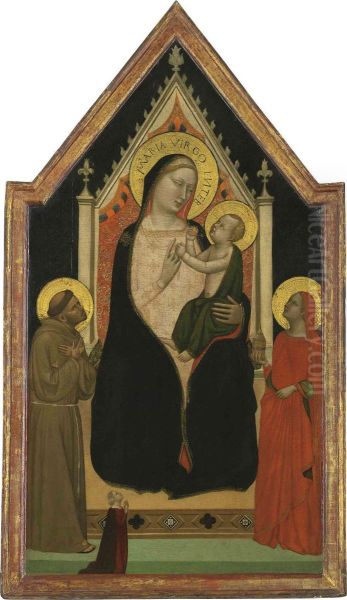
Bernardo Daddi's unique artistic voice emerged from his masterful synthesis of these diverse influences. From Giotto, he adopted the pursuit of three-dimensional form and the ability to convey human emotion with directness. His figures, while not possessing the same monumental weight as Giotto's, have a tangible presence and interact within coherently rendered spaces. This is evident in the way he constructs his narratives, ensuring clarity and emotional resonance.
However, Daddi infused this Giottesque foundation with a distinct Sienese elegance. His figures often exhibit a gentle sway, delicate features, and an aristocratic refinement. His palette is rich and varied, often employing vibrant hues and intricate gold tooling, a hallmark of Sienese luxury. This blend resulted in works that were both spiritually profound and aesthetically pleasing, appealing to a wide range of patrons, from religious orders to wealthy private citizens. He demonstrated a particular talent for depicting tender interactions, especially in his numerous Madonna and Child paintings, where the Virgin’s gentle gaze and the Child’s playful gestures convey a relatable humanity.
Hallmarks of Daddi's Artistic Language
Daddi's paintings are recognizable for several key characteristics. He possessed an exceptional eye for detail, meticulously rendering fabrics, architectural elements, and decorative patterns. This attention to detail did not, however, detract from the overall harmony of his compositions. His use of color was sophisticated, often employing subtle gradations and harmonious juxtapositions to create a sense of warmth and richness. Gold leaf was used extensively, not just for halos and backgrounds, but also for intricate patterns on garments (sgraffito) and tooled borders, enhancing the preciousness of his panels.
In terms of emotional expression, Daddi excelled at conveying a sense of gentle piety and lyrical tenderness. While capable of depicting dramatic scenes, his prevailing mood is one of serene devotion. His figures, though idealized, often display subtle psychological nuances that invite contemplation. He was particularly adept at organizing complex multi-figure compositions, especially in his triptychs and polyptychs, ensuring that each saint and scene contributed to the overall devotional message.
The Rise of the Portable Altarpiece and Daddi's Contribution
One of Bernardo Daddi's most significant contributions was his role in popularizing the small-scale, portable altarpiece, particularly the triptych. These hinged, three-panel works were designed for private devotion, easily transportable, and could be closed for protection. The increasing wealth of the merchant class and a growing emphasis on personal piety in the fourteenth century created a burgeoning market for such objects.
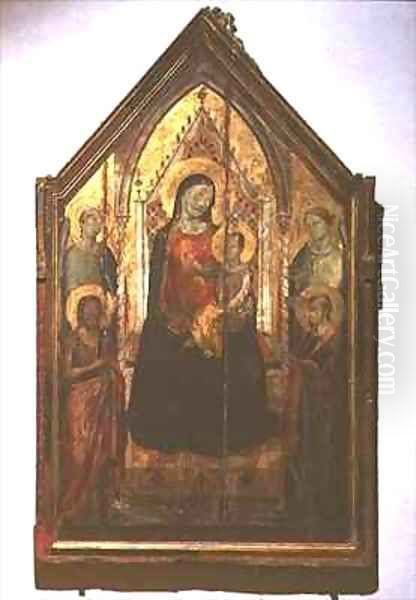
Daddi's workshop became a leading producer of these portable altarpieces. His ability to condense complex iconographies into a smaller format, while retaining clarity and devotional power, was highly valued. These works often featured a central image of the Madonna and Child or the Crucifixion, flanked by saints, scenes from the life of Christ, or donor portraits. The intimate scale encouraged a personal connection between the viewer and the sacred figures, making them ideal for use in private chapels, homes, or during travel. The Bigallo Triptych is a prime example of this format, showcasing his skill in narrative and devotional imagery.
Major Commissions and Representative Works
Bernardo Daddi's prolific career yielded a substantial body of work, much of which survives today in museums and collections worldwide. Among his most important commissions and representative pieces are:
The Orsanmichele Triptych (c. 1333-1347, Uffizi Gallery, Florence): Originally created for the Orsanmichele, a significant civic and religious building in Florence, this large-scale work depicting the Madonna and Child Enthroned with Saints is a testament to Daddi's ability to handle major public commissions. It showcases his mature style, blending Giottesque monumentality with his characteristic refinement.
The Bigallo Triptych (1333, Museo del Bigallo, Florence): This iconic work, possibly a collaboration or a commission involving Taddeo Gaddi, depicts the Madonna and Child with saints and scenes related to the charitable activities of the Compagnia della Misericordia. It is a key example of Daddi's mastery of the triptych form and his narrative skill.
The Coronation of the Virgin (various versions): Daddi painted this theme multiple times, with notable examples in the Accademia Gallery in Florence, the National Gallery in Washington D.C. (part of a dispersed polyptych, c. 1337-1339), and a significant, reassembled polyptych now in the Metropolitan Museum of Art, New York. These works are celebrated for their celestial splendor, delicate figures, and harmonious compositions.
Madonna and Child Panels: Daddi produced numerous variations of the Madonna and Child, a staple of devotional art. Examples include the Madonna and Child with St. Louis, St. Catherine, etc. (1340, Metropolitan Museum of Art, New York) and the Madonna and Child with Saints and Donors (1333, Museo del Bigallo, Florence, distinct from the triptych). These panels highlight his ability to convey maternal tenderness and divine grace.
Crucifixion (c. 1325-1330, Courtauld Gallery, London, and other versions): Daddi's depictions of the Crucifixion, while adhering to traditional iconography, are imbued with a poignant emotional depth, capturing the sorrow of the Virgin and St. John at the foot of the cross.
His works are also found in the Vatican Museums, the J. Paul Getty Museum, the National Gallery in London, and many other prestigious institutions, underscoring his widespread appeal and the productivity of his workshop.
The Workshop of Bernardo Daddi
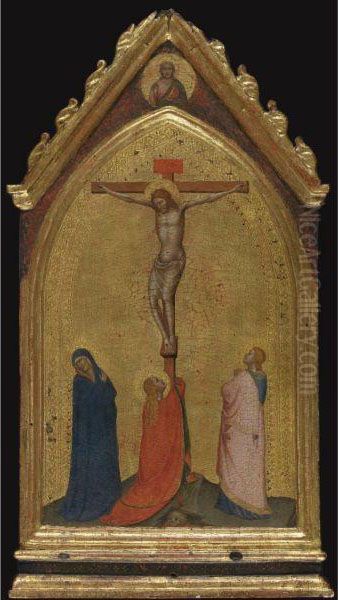
Like many successful artists of his era, Bernardo Daddi operated a large and highly productive workshop. This workshop system was crucial for meeting the high demand for his paintings. Daddi would have been responsible for the primary designs and the execution of the most important figures and passages, while trusted assistants and pupils would have worked on backgrounds, secondary figures, and preparatory stages, all under his close supervision.
The output of the Daddi workshop was remarkably consistent in quality, reflecting his strong guidance and the skill of his collaborators. This collaborative environment also served as a training ground for younger artists, who would learn their craft by imitating the master's style and techniques. The efficiency of his workshop allowed Daddi to undertake numerous commissions simultaneously, ranging from large altarpieces for churches to smaller panels for private patrons. The sheer volume of works attributed to Daddi and his workshop attests to his commercial success and the high regard in which his art was held.
Contemporaries, Collaborations, and Influence
Bernardo Daddi was a prominent figure in the vibrant artistic milieu of Trecento Florence. He was a contemporary of other significant Giottesque painters, including Taddeo Gaddi (Giotto's godson and long-time collaborator) and Maso di Banco, known for his powerful and sculptural figures. There is evidence to suggest a degree of professional interaction, and possibly even collaboration, between Daddi and Taddeo Gaddi. Some scholars propose they may have had a commercial arrangement to divide the market, with Daddi focusing more on panel paintings and Taddeo on frescoes, though both worked in both media. The Bigallo Triptych is sometimes cited as a potential collaborative effort or a project where their workshops might have interacted.
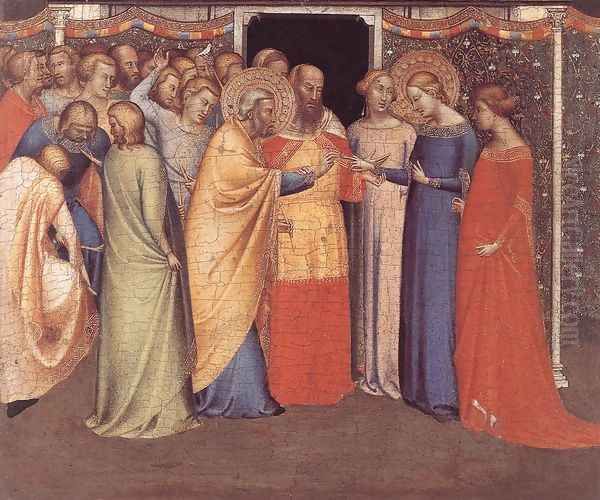
Daddi's style, with its appealing blend of Giottesque structure and Sienese lyricism, exerted considerable influence on his contemporaries and younger artists. His workshop produced numerous followers who continued to work in his manner. Artists such as Allegretto Nuzi, who later worked in Fabriano and helped spread a Daddesque influence to the Marches region (including Urbino), and Puccio di Simone are considered to have been his pupils or close associates. Even artists who developed more distinct styles, like Andrea Orcagna and his brothers Nardo di Cione and Jacopo di Cione, who became dominant figures in Florentine painting after the Black Death, would have been aware of Daddi's work and likely absorbed aspects of his refined technique and compositional solutions. Other Florentine painters of the period, such as Giovanni da Milano, who brought a Lombard sensibility to Florence, and Agnolo Gaddi (Taddeo's son), would have formed part of this rich artistic tapestry.
The Shadow of the Plague and Personal Tragedy
The mid-fourteenth century was marked by a catastrophic event: the Black Death. This devastating pandemic swept across Europe between 1347 and 1351, wiping out a significant portion of the population. Florence was hit particularly hard in 1348. The plague had a profound impact on society, culture, and art, leading to shifts in patronage, subject matter, and even artistic style, with some art historians noting a turn towards more conservative or intensely penitential themes.
Bernardo Daddi's personal life was also touched by tragedy, likely compounded by the plague. Sources suggest his wife predeceased him, and he was left to care for two orphaned children, Daddo and Francesco, with the help of his daughter, Beatrice. It is possible that Beatrice herself succumbed to the plague. Ultimately, Bernardo Daddi himself fell victim to the Black Death in August 1348. His death, along with those of other prominent artists like Ambrogio Lorenzetti and possibly Pietro Lorenzetti in Siena around the same time, marked the end of an era and created a void in the artistic landscape of Florence.
Daddi's Enduring Legacy
Despite his untimely death, Bernardo Daddi's artistic legacy was substantial and enduring. His workshop, likely continued by his pupils, ensured that his style and approach to devotional painting remained influential for several decades. He played a crucial role in popularizing the small-scale devotional altarpiece, a format that would continue to flourish throughout the Renaissance. His ability to create works that were both spiritually resonant and aesthetically delightful set a standard for religious art in Florence.
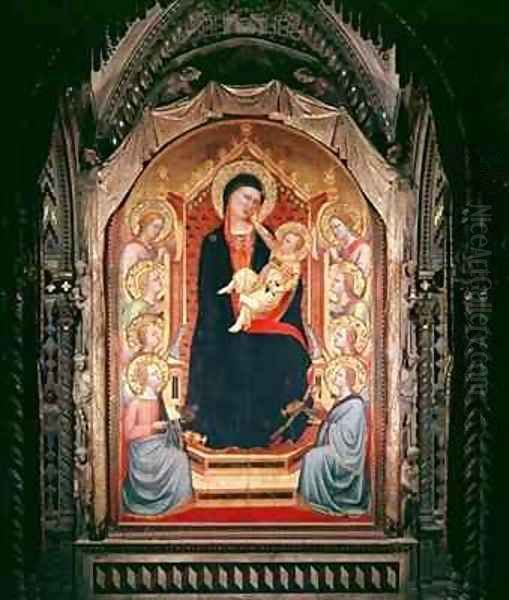
Daddi's synthesis of Giotto's naturalism with Sienese elegance provided a compelling alternative to the more austere Giottesque style, offering a softer, more lyrical, and often more decorative vision. He demonstrated that intimate, small-scale works could possess a profound spiritual depth and artistic sophistication. While later Renaissance masters like Masaccio and Fra Angelico would forge new paths, the foundations laid by artists like Bernardo Daddi were crucial for the development of Florentine painting. His contribution lies not only in the beauty and skill of his individual works but also in his broader impact on the visual culture and devotional practices of his time. He remains a key figure for understanding the rich artistic currents of the Italian Trecento.
Conclusion
Bernardo Daddi was more than just a follower of Giotto; he was an innovative artist in his own right who carved out a distinct and influential niche in the competitive art world of fourteenth-century Florence. His ability to fuse the monumental with the delicate, the narrative with the lyrical, resulted in a body of work that captivated his contemporaries and continues to be admired today. Through his prolific workshop and his popularization of the portable altarpiece, Daddi significantly shaped the course of Florentine painting and left a lasting legacy as a master of devotional art, whose gentle and refined style provided solace and inspiration during a tumultuous period in European history. His paintings remain a testament to his skill, his piety, and his enduring importance in the story of Italian art.